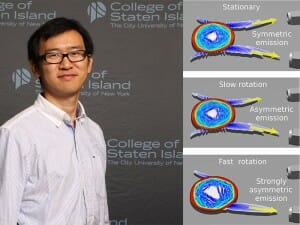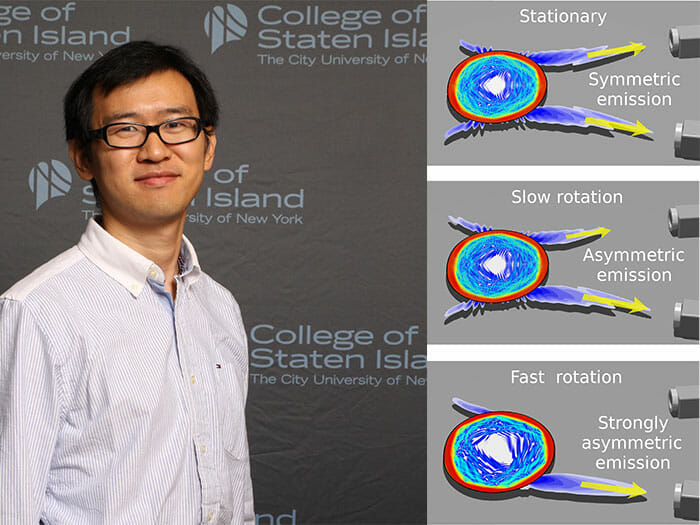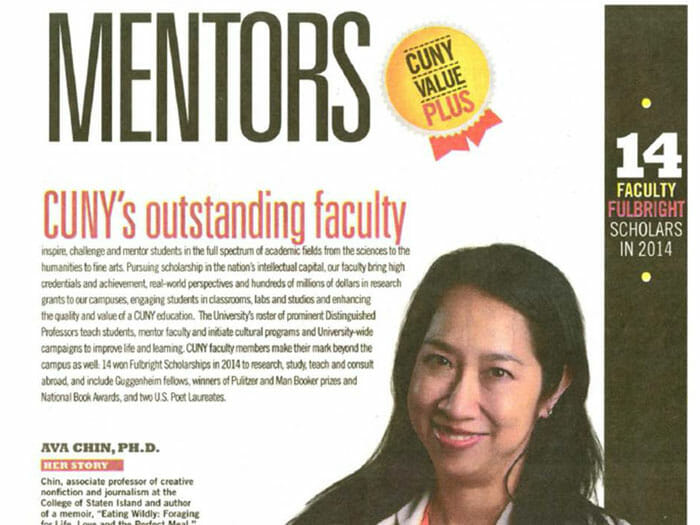Light-Powered Gyroscope is World’s Smallest: Promises a Powerful Spin on Navigation Technologies

Dr. Li Ge was a postdoctoral associate in the Department of Electrical Engineering at Princeton University before joining the faculty of CSI in Fall, 2013. He received his PhD in Physics from Yale University in 2010. He is pictured here alongside schematics that show the far-field emission pattern of a microdisk cavity depends strongly on rotation, and in this case changing from symmetric to strongly asymmetric. The two cameras on the right monitor this change, based on which the rotation speed can be calculated. The yellow arrows indicate the direction and amplitude of the two main emission beams, and the false color patches show the intensity patterns of light (in the logarithmic scale).
A pair of light waves – one zipping clockwise the other counterclockwise around a microscopic track – may hold the key to creating the world’s smallest gyroscope: one a fraction of the width of a human hair. By bringing this essential technology down to an entirely new scale, a team of physicists hopes to enable a new generation of phenomenally compact gyroscope-based navigation systems, among other intriguing applications.
“We have found a new detection scheme that may lead to the world’s smallest gyroscope,” Dr. Li Ge, a physicist at The City University of New York (CUNY) at the College of Staten Island (CSI).“Though these so-called optical gyroscopes are not new, our approach is remarkable both in its super-small size and potential sensitivity.”
Ge and his colleagues – physicist Hui Cao and her student Raktim Sarma, both at Yale University in New Haven, Connecticut – recently published their results in The Optical Society’s (OSA) new high-impact journal Optica.
More than creative learning toys, gyroscopes are indispensable components in a number of technologies, including inertial guidance systems, which monitor an object’s motion and orientation. Space probes, satellites, and rockets continuously rely on these systems for accurate flight control. But like so many other essential pieces of aerospace technology, weight is a perennial problem. According to NASA, it costs about $10,000 for every pound lifted into orbit, so designing essential components that are smaller and lighter is a constant struggle for engineers and project managers.
If the size of an optical gyroscope is reduced to just a fraction of a millimeter, as is presented in the new paper, it could then be integrated into optical circuit boards, which are similar to a conventional electric circuit board but use light to carry information instead of electric currents. This could drastically reduce the equipment cost in space missions, opening the possibility for a new generation of micro-payloads.
Since joining CSI, Li credits the many opportunities afforded to him by CUNY and CSI, including the PSC-CUNY Award, the Collaborative Incentive Research Grant (CIRG), the Steward Travel Award, and the Provost Research Fellowship, adding “without this support, my research would not have been as effective.” Since August 2013, Li’s research has appeared in 13 peer-reviewed journal publication, including several high-impact articles in Nature Photonics, Physical Review Letters, Physical Review X, and the current paper in Optica.
Putting a New Spin on Light-powered Gyroscopes
Quite different from mechanical gyroscopes, which are currently used on ships for stabilization and rockets for guidance, optical gyroscopes have no moving parts. Instead, dual light waves race around an optical cavity or fiber, constantly passing each other as they travel in opposite directions.
Traditional mechanical gyroscopes use Newton’s laws of motion to maintain stability and orientation. These same physics principles, however, do not apply to light, so measuring motion requires looking for telltale yet very subtle optical signals instead.
One such signal comes from the unusual property of light known as the Sagnac effect, which – put simply – creates a measurable interference pattern when light waves split and then recombine upon leaving a spinning system. Commercial optical gyroscopes build on this principle, with their sizes varying from that of a baseball to a basketball. They could be made much smaller, but measuring rotation would require a much greater level of sensitivity than is currently available.
Making a Gyroscope Out of Light
Traditionally, engineers have used two approaches to make optical gyroscopes, both based on the Sagnac effect. The first one uses an optical cavity – an engineered structure on a crystal – to confine light and the second one uses an optical fiber to guide light.
The second approach has, to date, been most practical because its sensitivity can be easily enhanced by using longer sections of optical fiber (some up to five kilometers long). These lengths of fiber would then be wrapped around an object about five centimeters in diameter, achieving a more manageable size. Though this system is sensitive to rotation, there are practical limits to how long the fiber can be and how small it can be wrapped before the fiber itself is damaged.
To go truly small, optical cavities seem to be the preferable option, where the Sagnac effect manifests as a subtle color change. The problem, however, has been that the sensitivity of this type of optical gyroscopes degrades as the cavity gets smaller.
“This issue was the roadblock that has hindered scientists from developing tiny optical gyroscopes,” noted Ge. “There have been several attempts to get around this limitation, but they could not get around the real problem, the Sagnac effect itself.”
The researchers were able to overcome this hurdle by using a very different principle based on far-field emission. Rather than directly measuring the color change of the light waves, the researchers determined that they could measure the pattern the light produced as it exited the cavity.
“That was our key innovation – finding a new signal with a much improved sensitivity to rotation,” said Ge. “Optical gyroscopes optimized to produce and detect this new signal, we found, could be about 10 microns across – smaller than the cross section of a human hair.”
The idea is similar to rotating an uncovered light bulb. You can’t see any direct spinning, but on small scales, the act of rotation itself causes a small but measurable relativistic effect – slightly bending space in and around the light source. This then almost imperceptibly distorts the pattern on the wall. If measured, however, the speed of rotation can be calculated from the degree of distorting.
Spinning the Gyroscope
To start the new optical gyroscope, light waves are first pumped into the optical cavity. This naturally produces light waves traveling in both clockwise and counterclockwise directions. This behavior is similar to plucking a guitar string in the middle, sending vibrations in both directions simultaneously.
By carefully designing the shape of the optical cavity, the researchers were able to control where both waves would exit. Normally, cavities are designed to trap light as long as possible. Here, the researchers needed to balance the light trapping properties of the cavity with the need for some light to escape to create a far-field emission pattern. This pattern is observed by placing a pair of camera-like detectors facing the cavity at different angles that move along with the cavity. This allows them to continuously monitor the pattern for distortions that would reveal the speed of rotation.
Though this only reveals one plane of motion, multiple such sensors at different orientations would be able to give a fully three-dimensional picture of how the object is moving.
Next Steps and Technology Development
According to the researchers, further studies are needed to take into consideration the possibility that many modes, or light paths, exist simultaneously in the cavity. Their far-field emission patterns may change in different ways, which causes a reduction of the sensitivity to rotation. The researchers are currently working on different methods to control this effect.
Paper: L. Ge, R. Sarma, and H. Cao, “Rotation-induced evolution of far-field emission patterns of deformed microdisk cavities,” Optica, 2, 4, 323-328 (2015) http://www.opticsinfobase.org/optica/abstract.cfm?uri=optica-2-4-323
doi: http://dx.doi.org/10.1364/OPTICA.2.000323
# # #
About Optica
Optica is an open-access, online-only journal dedicated to the rapid dissemination of high-impact peer-reviewed research across the entire spectrum of optics and photonics. Published monthly by The Optical Society (OSA), Optica provides a forum for pioneering research to be swiftly accessed by the international community, whether that research is theoretical or experimental, fundamental or applied. Optica maintains a distinguished editorial board of more than 20 associate editors from around the world and is overseen by Editor-in-Chief Alex Gaeta of Cornell University. For more information, visit http://optica.osa.org.
About OSA
Founded in 1916, The Optical Society (OSA) is the leading professional organization for scientists, engineers, students and entrepreneurs who fuel discoveries, shape real-life applications and accelerate achievements in the science of light. Through world-renowned publications, meetings and membership initiatives, OSA provides quality research, inspired interactions and dedicated resources for its extensive global network of optics and photonics experts. OSA is a founding partner of the National Photonics Initiative and the 2015 International Year of Light. For more information, visit www.osa.org.


















